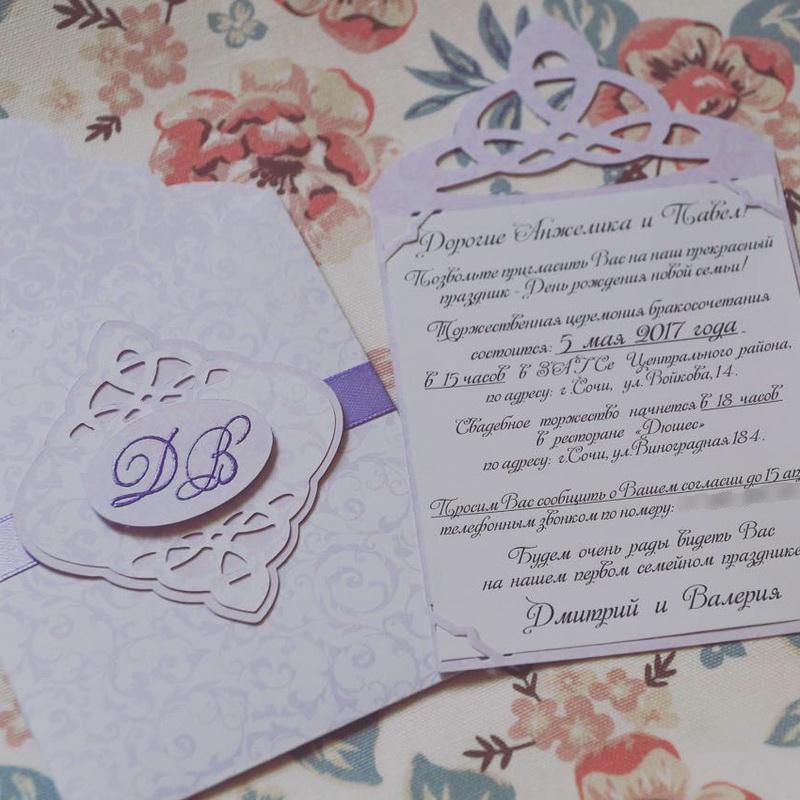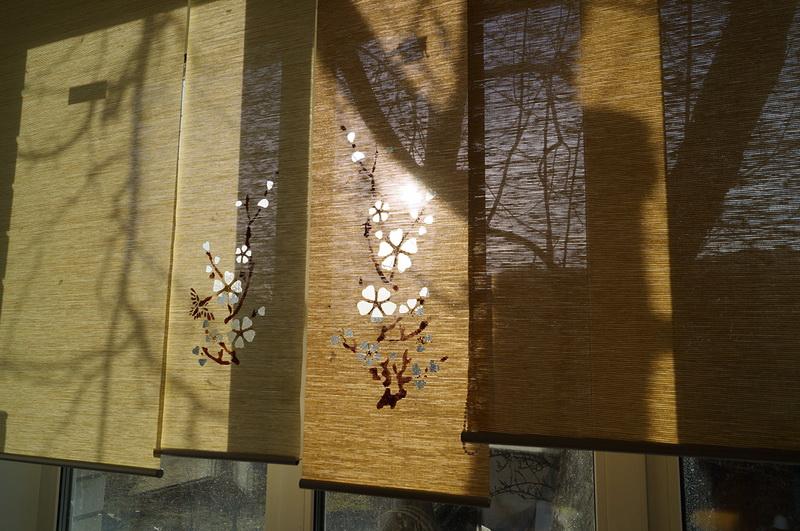Search the Community
Showing results for tags 'scanncut'.
-
Custom wedding invitation I began preparing for my wedding with the making of the wedding invitations. The wedding is a pretty important occasion in the life of a woman, so I took the matter seriously. Naturally, I wanted my invitations to be hand-made and original. In this, I succeeded. Tools and materials 2 sheets of scrapbooking paper, size 30.5*30.5 cm (I used Fleur Design Romantic Vintage and Romantic Patterns) A satin ribbon 1.2 cm wide A heat gun Embossing powder Alphabet stamp (Russian letters “В” and “Д” in my case) An embossing ink pad An acrylic stamping block Talcum powder and sponge (for degreasing) A cutting mat Sticky foam pads Glue Double-sided adhesive tape (narrow) Scissors, ruler, pencil, design knife, a pair of tweezers A creasing tool A corner hole punch for the insertion of the photograph First, I created files for cutting in the Canvas Workspace and transferred the designs to the cutting machine via USB flash drive. I used the slightly sticky cutting mat and a standard knife. Before the work started, I adjusted the knife (the paper density is very important here) and did several test cuts. Only after that, I proceeded to the scanning and positioning. I cut the following details: an envelope, an insert piece, and some decorative elements for the front part of my invitation (a carrier with two openings, a carved edge decoration, and an oval thing). If the cutting machine has left something uncut, don't panic. You can easily remedy it with a design knife. To get the neat-looking, I smoothed them out on all sides with a creasing tool and also made some folding creases on the envelope (center part and sides — let’s call them “wings”). I stuck small strips of adhesive tape on both “wings” and glued the parts of the envelope together. This resulted in a lot of workpieces. Using my hole punch, I made several openings the insert piece so that I could put in the text sheet later (you may glue it or use Canvas Workspace instead). I also decided to emboss the bride and bridegroom’s initials (you may just stamp them with ink or glue the word “Invitation” or something). For embossing, you’ll need: A heat gun Embossing powder An embossing ink pad “В” and “Д” stamps An acrylic stamping block Talcum powder and sponge (for degreasing) First, I prepared the surface, using talcum powder and sponge (so that the small particles of the embossing powder only stuck to the parts I had applied my stamp to). Then I used the pad to create the inscription, sprinkled the embossing powder, shook off the excess and heated the inscription. As the heat gun gets really hot, I recommend holding your paper with tweezers. All is ready for the assembling of the invitation: An envelope blank An insert piece Three decorative elements: The carrier with two openings, the decoration with carved edges and the oval thing with embossing A satin ribbon 1.2 mm wide Sticky foam pads Glue A ruler and scissors I held the ribbon to the envelope, measured the required length (it should be sufficient to go around the envelope), and cut. I could have singed the edge with a lighter, so as to prevent it from unraveling, but decided not to, for the ends were to be glued. Then I passed the ribbon through the carrier and glued one end of it almost at the center (use any glue you like). Then I pulled the ribbon tight, overlapped, and glued the second edge. I shifted the carrier toward the center so that it covered that spot. I used glue to attach the decoration with the carved edges, but you may replace it with double-sided adhesive tape. Then, I stuck the oval thing with embossing (my inscription) to the sticky foam pads. Our wedding invitation is ready. All that’s left to do is to print the text with the vital details about the wedding and to attach it. Original text by Valeria Balashova
-
Cherry tree blossom: revamping old roller shades Roller shades have become a customary part of our homes. Thanks to the huge variety of textures and sizes, they can be easily adjusted to fit into our interior environments. And, should you make some changes to your interior design (I did), you can easily transform them, let’s say, by adding an oriental touch – a cherry tree blossom to remind you of the first rays of sunshine. For this tutorial, I’ll be using a design found on the Internet. I’ll alter it a bit, then cut it out using ScanNCut, and after that add some finishing touches with the help of a stencil. Materials Two pieces of roller shade material to fit your windows + fittings or two ready roller shades 30 cm wide. ScanNCut machine. Standard mat, 30 or 60 cm long, depending on the size of your design. A piece of paper large enough to fit your stencil. White craft glue. Fabric paints (I used acrylic). A sponge (or a paintbrush). A design. First, I made some changes to the picture I found (a cherry tree branch) in Canvas Workspace (the former ScаnNCutCanvas). You’ll need 2 files, one for making a stencil, and another one for cutting the roller shade. Open the image in your Canvas Workspace, go to Image Tracing, and press Color–Preview–OK. Select all objects, right-click and press Group. Save the result to a USB flash drive. This is our file No1. We’ll use it to create a stencil. Now, we proceed to the pattern for the shade. We’ll only need those objects that are going to be cut. Select all stems on the image and press Delete. Only the flowers should be left. This is our file No2. We’ll use it to cut the roller shade. Select all objects, right-click and press Group. Save the result to USB flash drive. (In order for the patterns on the shades to differ slightly, I deleted several flowers on the bottom and saved them into a separate file). Let’s prepare our roller shades. I cut 30 cm from each piece of fabric, thus getting two shades 30 cm wide (because my cutting mat is 30 cm wide). Metallic tubes on top and bottom of every shade should be filed with a mill file. Slide the bottom hem of the shade from the metal tube and detach the cardboard strip. Or, you may use a couple of existing roller shades, 30 cm wide each. In that case, you’ll only need to de-tube them and remove the strips. Secure the bottom edge of the shade to the mat and do the test cut. (Blade length 5, pressure 4. Other values may be used, depending on the material your roller shade is made of). Open file No2 in ScanNCut. Now let’s alter the design a bit: first invert it, then check the size and placement. Cut out your pattern and unpeel it from the mat. Repeat with the second roller shade. Change the size and placement of the design and cut. Apply some white craft glue to the wrong side of the narrow parts to give them additional strength. After the glue dries, it won’t be visible. Cut out a paper stencil, using file No1. Blade length 4, pressure 0. Align your stencil with the pattern on the shade and secure it with pieces of an adhesive tape. To be on the safe side, I also taped over the flowers, to prevent the paint from getting there. Squeeze the paint onto the paper, dip your paintbrush/sponge into it and start tapping on the openings in the stencil. It will take approximately 5 hours for the paint to dry. After that, take away your stencil, attach strips of cardboard to the bottom parts of the shades and insert metallic tubes. Attach fittings to the narrow shades and put them up. Hopefully, this will add a bit of sunshine into your winter homes. The idea for the decoration in this tutorial was found on the Internet. Original text by Maria Bespalova





